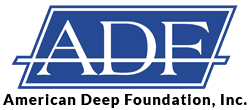We can perform all types of piles and excavation bracing on a “Design Construct” basis.
DRILLED PILES
 Auger Cast Piles (Also known as Augered Cast in Place piles, Continuous Flight Auger Piles (CFA Piles)) or simply Auger piles. We install auger cast piles typically 12 inches to 36 inches in diameter with lengths up to and in excess of 100 feet. Capacities typically range from 30 to 150 tons.
Auger Cast Piles (Also known as Augered Cast in Place piles, Continuous Flight Auger Piles (CFA Piles)) or simply Auger piles. We install auger cast piles typically 12 inches to 36 inches in diameter with lengths up to and in excess of 100 feet. Capacities typically range from 30 to 150 tons.
Learn More About Auger Cast Piles
 Helical Anchors (Also known as screw piles and helical piers. A well-known brand name is Chance.) We install helical anchors designed in compression for bearing piles or in tension as tension anchors. When applicable we may install helical anchors as tie backs in our shoring design.
Helical Anchors (Also known as screw piles and helical piers. A well-known brand name is Chance.) We install helical anchors designed in compression for bearing piles or in tension as tension anchors. When applicable we may install helical anchors as tie backs in our shoring design.
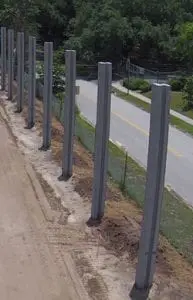 ADF personnel has experience drilling and installing posts for precast concrete sound walls. Large diameter auger cast piles are installed through a carefully placed template allowing the precast posts to be set and locked in the proper position.
ADF personnel has experience drilling and installing posts for precast concrete sound walls. Large diameter auger cast piles are installed through a carefully placed template allowing the precast posts to be set and locked in the proper position.
 Drilled Micro piles (Also known as mini piles, pin piles, needle piles or root piles). We install several types of micro piles in all types of soil and rock or karst conditions. Our micro piles typically range from 3 inches to 12 inches in diameter with lengths to well over 100 feet and capacities to 300 tons or above.
Drilled Micro piles (Also known as mini piles, pin piles, needle piles or root piles). We install several types of micro piles in all types of soil and rock or karst conditions. Our micro piles typically range from 3 inches to 12 inches in diameter with lengths to well over 100 feet and capacities to 300 tons or above.
Learn More About Drilled Micro Piles
DRIVEN PILES
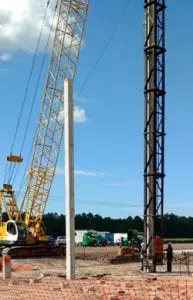 We most commonly install 12 inch and 14 inch square precast – prestressed concrete piles. These piles are most competitive if the pile lengths can be determined with some accuracy before the piles are shipped from the supplier and the shipping distance is not too great.
We most commonly install 12 inch and 14 inch square precast – prestressed concrete piles. These piles are most competitive if the pile lengths can be determined with some accuracy before the piles are shipped from the supplier and the shipping distance is not too great.
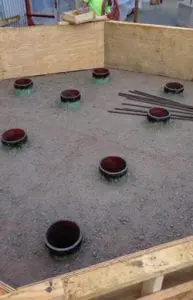 The availability of pipe that is manufactured for the petroleum industry but does not meet the strict chemical properties and straightness tolerances give pile designers a product that yields results similar to those of an H pile at a reduced cost. Pile piles can be driven open ended as a structural steel pile or the tip of the pile can be closed with a plate. If a plate is installed the piles can be filled with concrete to improve the load carrying capacity and the corrosion resistance. We install pipe piles extensively.
The availability of pipe that is manufactured for the petroleum industry but does not meet the strict chemical properties and straightness tolerances give pile designers a product that yields results similar to those of an H pile at a reduced cost. Pile piles can be driven open ended as a structural steel pile or the tip of the pile can be closed with a plate. If a plate is installed the piles can be filled with concrete to improve the load carrying capacity and the corrosion resistance. We install pipe piles extensively.
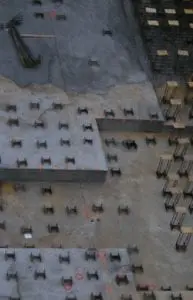 We install steel H piles for several major projects every year. HP10X42, HP12X52 and HP14X73 are the most common sizes; however other sizes are used as well. Since H piles can be spliced, they can be driven to almost any depth. Should lengths vary, pile material can be cut off one pile, driven again or welded to extend another pile.
We install steel H piles for several major projects every year. HP10X42, HP12X52 and HP14X73 are the most common sizes; however other sizes are used as well. Since H piles can be spliced, they can be driven to almost any depth. Should lengths vary, pile material can be cut off one pile, driven again or welded to extend another pile.
Learn More About Steel H Piles
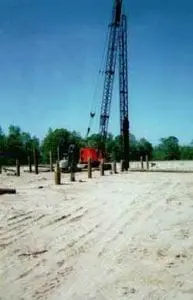 Timber Piles (Also known as wood piles). Timber Piles have been installed for foundations for centuries. They are probably the most tried and true deep foundation available and are still extensively used today. Typically we install timber piles for compression loads of up to 40 tons and lengths to 60 feet.
Timber Piles (Also known as wood piles). Timber Piles have been installed for foundations for centuries. They are probably the most tried and true deep foundation available and are still extensively used today. Typically we install timber piles for compression loads of up to 40 tons and lengths to 60 feet.
SHORING, EARTH RETENTION, EXCAVATION BRACING, COFFERDAMS
 Interlocking sheet piles are driven or vibrated into the ground to form a wall or a box called a cofferdam to allow excavation or fill without the requirement for a slope or to build a wall or prevent erosion along a body of water. Sheet piles are normally made of steel, but for less demanding projects plastic and vinyl can be used.
Interlocking sheet piles are driven or vibrated into the ground to form a wall or a box called a cofferdam to allow excavation or fill without the requirement for a slope or to build a wall or prevent erosion along a body of water. Sheet piles are normally made of steel, but for less demanding projects plastic and vinyl can be used. Precast concrete sheet piles are typically used for sea walls or in other places where permanent protection from scour is required but can also be used for other retaining walls. Precast concrete sheet piles are typically installed in sandy conditions by jetting.
Precast concrete sheet piles are typically used for sea walls or in other places where permanent protection from scour is required but can also be used for other retaining walls. Precast concrete sheet piles are typically installed in sandy conditions by jetting.
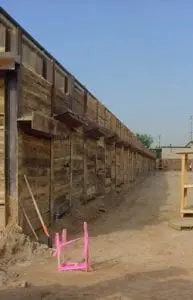 H piles can be driven or inserted into drilled holes in order to laterally support a shoring system of lagging placed horizontally between the flanges of the H piles. Lagging is most typically rough cut hardwood planks 3 to 6 inches thick, but precast concrete panels or steel plate can also be used.
H piles can be driven or inserted into drilled holes in order to laterally support a shoring system of lagging placed horizontally between the flanges of the H piles. Lagging is most typically rough cut hardwood planks 3 to 6 inches thick, but precast concrete panels or steel plate can also be used.
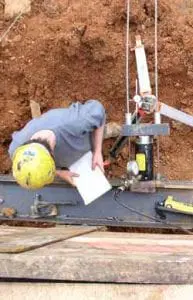 Tiebacks are drilled at an angle below horizontal to transfer the lateral load on the shoring behind the failure plane of the soil that the shoring is supporting. The backs can either be grouted in place and achieve their capacity from friction between the grouted anchor and the subsurface or they can be helical and achieve their capacity through the interaction of the helixes with the subsurface. Soil Nails are like smaller tie backs that are used to stabilize slopes. They are usually connected by wire mesh covered with shotcrete.
Tiebacks are drilled at an angle below horizontal to transfer the lateral load on the shoring behind the failure plane of the soil that the shoring is supporting. The backs can either be grouted in place and achieve their capacity from friction between the grouted anchor and the subsurface or they can be helical and achieve their capacity through the interaction of the helixes with the subsurface. Soil Nails are like smaller tie backs that are used to stabilize slopes. They are usually connected by wire mesh covered with shotcrete.
GROUND IMPROVEMENT
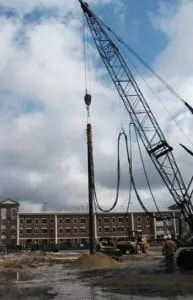 Vibro Compaction, Stone Columns, Aggregate Piers – (Similar methods or products – vibro floatation, vibro replacement, Geo Piers™, vibro displacement) These products reduce settlement and liquefaction potential and sometimes can allow the use of spread footings in place of deep foundations.
Vibro Compaction, Stone Columns, Aggregate Piers – (Similar methods or products – vibro floatation, vibro replacement, Geo Piers™, vibro displacement) These products reduce settlement and liquefaction potential and sometimes can allow the use of spread footings in place of deep foundations.
SOUTH CENTRAL OFFICE
info@AmericanDeepFoundation.com
EAST COAST OFFICE
GEORGIA OFFICE
info@AmericanDeepFoundation.com
NORTH CAROLINA OFFICE
